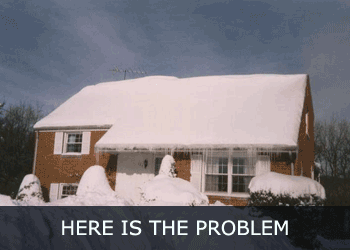WHY ICE PROTECTION

- Ice Formation
- Dangers of Ice
- Ice Damage
- Ineffective Solutions to Ice Formation
- Why Heater Cap is the Best Solution to Ice Formation in Gutters
Ice forms on your roof and gutters in various ways. Let’s examine the process going from your roof to the down spouts.
If you've ever been in your attic, you should notice two things. There's dead air space between the roof and the ceiling of your home, and there's a large volume of insulation on the floor of the attic. If the attic is properly vented and insulated, there should be no transfer of heat through the ceiling of your home to the attic. The attic is a buffer between your living space and the roof. Sparsely insulated attics without proper ventilation cause the attic to transfer heat to the roof. This heat transfer melts the snow and ice on the roof. The ice melt drains into the gutters and eventually overflows as icicles.
Cathedral ceilings are notorious for excessive ice formation because they do not allow a buffer zone between living space and the roof. Also there isn't adequate space for the proper amount of insulation. Consequently, there is considerable heat transfer with cathedral ceilings to the roof.
Roof valleys (where two or more sections of the roof meet) act as a funnel on the roof. In the winter time, glaciers of ice and snow cascade down the roof valleys. Massive ice dams commonly occur at these points.
Snow accumulates in the gutters. Further layers of ice in the gutters are accumulated from ice melt coming off of the roof. Eventually the gutters fill up and overflow with ice.
The standard 2x3 down spout is inadequate for the icy conditions in a northern climate. Typically, ice blocks the bottom of the spout at the elbow and the accumulation of ice eventually works its way up the down spout and adds to the ice in the gutters.
If there are gutter covers on the gutters whether it's a mesh, sponge, bristle, or some sort of dome cover, icicles will form much sooner than without gutter covers.. The formation of icicles is noticeable sooner since the ice doesn't have to overflow in the gutters first. It's very common to see icicles in new areas of the home after installing gutter protection.
Some gutter guards promote that their system inhibits the formation of ice. Unless the system is heated, this claim is false
Falling ice and ice melt refreezing on walkways is a serious hazard.
Icicles have sharp points. During a thaw, it's not uncommon to see icicles that have speared into the ground from the roof. The potential for injury is a reality.
Sometimes, ice may form in areas hidden until it's too late. An example would be where water melted onto the soffit, formed a block of ice a few inches thick and then collapsed from the weight of the ice. A two or three inch block of falling ice could cause some serious injuries.
Who hasn't at some point in life slipped and fallen on ice? When you're a kid it's not as bad. As you get older, the chance of serious injuries increases. Icicle formation on the roof and gutters drips ice melt onto the ground. The ice melt refreezes on walkways and creates a serious hazard. This is the most common injury associated with ice formation. An elderly person falling on the ice may spend several weeks in the hospital along with spending several thousands of dollars towards medical bills.
During the colder months, water gets in between vulnerable structures in your home. What happens when the water freezes? The expanding ice pries gutters, soffit, fascia, roof shingles, and other structures apart from the home.
In the northern climates, ice causes considerable damage. The gutter system is full of ice because frozen water doesn't flow. Instead, water and ice accumulates and does extensive damage to the home.
Roof damage is very common because of ice dams. The cup-like shape of the gutters forms an anchor hold for the ice to get up underneath the first row of shingles, which is the first line of defense for the roof. Ice pries up the shingles wrecking them, and water works its way under the shingles and into the attic. Eventually, the ice melts and causes water damage in the ceiling.
A ten foot piece of gutter filled with ice weighs around 150 pounds. This amount of weight would be the equivalent of walking on the gutters. Would anyone in their proper state of mind walk on their gutters?
In addition, water gets in between the gutters and the fascia. When the water freezes, it pries the gutters away from the home, and the excessive weight of the accumulated ice collapses the gutters.
A mid winter thaw can compound the problem. With the gutters being partially or totally clogged, winter rains will flow to the vulnerable areas of your home. Water logged wood refreezes, expands, and separates and crumbles. In the warmer months, the soaked wood will be broken down more by mold and fungus. Insects such as carpenter ants will complete the destruction.
Heat wire and heat tape, besides being inefficient, are very dangerous.
Heat tape and wires can be bought at the hardware store. They're usually installed by the homeowner. There's a good reason why we have licensed electricians. Electricity is dangerous. Many heat tape and wires are not temperature regulated and can potentially catch structures on fire. After all, the asphalt in the shingles is an oil derivative and is flammable, along with any wood structures that come in contact with the wire. The insulation covering some of these products is thin and easily nicked which increases the potential for fires. These products are usually hooked up to a plug-in to an outside outlet.
The "plug-in" component causes other issues as well. It's anybody's guess as to what other circuits are competing for power with that outlet. Dimming of Christmas lights or circuit tripping are common problems. Some of the plug-in connections have the proper GFI component, but lack an EPD (equipment protection device) breaker at point of the breaker box to prevent nuisance tripping. These breakers are very expensive, but they have a 30 milliamp trip which is the minimum needed to prevent nuisance tripping. A conventional breaker has 5 milliamps. The NEC or National Electric Code insists that self-regulating cables must be connected to an EPD breaker. The effectiveness of an ice melt system is negated if there is the potential for the system to accidentally turn off by a nuisance trip.
Heat tapes and wires are not efficient at melting ice. Only the area immediately around the wire gets melted, sometimes creating ice tunnels. The ice issue is still there.
Heat wires and tapes look horrible up on the roof. Heat tape and wires are permanently mounted and are very visible all year round as they zigzag across the roof. The effect would be similar to the neighbor that leaves the Christmas lights up all year. Who wants to see that?
Heater Cap has a proven track record of preventing ice build up in the gutters.
Heated gutter covers can be added to the existing gutter protection. Or if there isn't a tree issue, they can be installed on the roof, gutters, and down spouts to protect against ice issues. Heater Cap has several advantages over most roof and gutter deicing systems:
- Self regulating, heavily insulated, heat cables only get warm enough to melt the ice and snow.
- A heat dispersing panel goes over the cable to melt large swaths of snow or ice off the roof and gutters.
- The roof valley is heated as well.
- The system is hardwired into its own separate circuit in the breaker box with a 20 or 30 amp GFI breakers with EPD (equipment protection) components.
- Heater Cap can be mounted in just the gutters and down spouts, or on the roof if organic debris is not an issue.
- Heater Cap can be retrofitted on most metal panel gutter guards.
- Heater Cap has been installed by a network of dealers since 2003. Experience has given enough time to work out the “bugs” in the system.
The installation of Heater Cap involves two contractors, one to install the heating panels and self regulating cable, and a licensed electrical contractor to hard wire it into the circuit breaker box. The electrician checks to ensure that the system is working and will not pop the circuit breaker. Proper procedures ensure a working system.
Not everything is without its drawbacks. You need to consider the energy usage. These systems pull the same amount of electricity equivalent to a hair dryer operating non-stop. Self-regulating cables draw more power as the outside temperature drops. Depending on the length of cable, a homeowner can accrue $.50 to $2.50 per day in additional energy costs.
A properly installed system will melt the snow and ice on a continual basis eliminating hazards from falling ice and slippery walk ways. Heater Cap is the best solution for these problems.










